Published Spring 2013
What I want to achieve here is a synthesis of some the emerging ideas about digital media with some of the ideas Guy Debord published in "The Society of Spectacle" back in 1967. Specifically the idea that "The spectacle is not a collection of images, but a social relation among people, mediated by images". Think of it as the corruption of Tim Rayner's observation "I Tweet therefore I become" into the more generic idea that life in the networked economy is in reality little more than "You shall know me by my lists"
I want to start by taking a quick look at brand called Jennifer and the idea that Branding is now seemingly about repeating patterns as an infinite Mandelbrot set.
You'll find Jennifer on Twitter @JenniferSertl, and at Agility3R.Com, and on LinkedIn, and on Facebook, and on Google+, and on YouTube, and on Pinterest, and on Amazon, and on Storify, and on Quora, but the easiest place to start your search for her is on Google.
Just go to Google and type in her name and you'll discover she is the owner of a very unique brand.
It's called Jennifer Sertl. And if you take the time to explore her *hyper-connected* world you'll see she is doing some very interesting things with social media as a marketing channel. She is in the business of creating repeating patterns of repeating patterns Mandelbrot sets. Especially on Twitter where she seems to be exploring the idea that Twitter is a lot like Google. Choose a key word for the day and then explore where this word takes you. I can't make my mind up if it the Googlification of Twitter or the Twitterfication of Google. But in the end the term is irrelevant because it is all about what Jennifer Sertl is thinking about, or at least discovering, curating and sharing today. And people are following the brand. A brand called Jennifer.
She, in Tim Rayner's words, Tweets to become... whatever it is she is seeking to become.
Now a simple observation. Two tools stood out for me during the PC era. Excel and Photoshop. The quintessential mash-up list engines. Spread sheets as list engines for mashing up numbers is obvious. Photoshop with its transparent layers for mashing up images, less so.
Both allow you to explore ideas and create new meanings far more rapidly and in more richer detail than a word processor or PowerPoint ever could.
Numbers and images. Truth and spectacle.
Mash it up into a chart and you have the spectacle of truth.
The infographic.
In this, the age of the networked economy. I would add a third tool. Twitter. Here again we have access to what is quintessentially a mash-up list engine. This time it all about mashing up Debord's spectacles. Or more accurately Twitter is perhaps best understood as the spectacle of the exchange of spectacles.
Which leaves us to contemplate the question: If you Tweet to become will you become whatever it is you are seeking to become or will you merely become part of the spectacle?
Hold onto that thought.
I was watching Waldemar Januszczak's documentary series The Impressionists over the weekend.
During the show he pointed out, in his own inimitable style, that the Impressionist painted modern people referencing the past masters. I guess you could say they offered a new way of seeing the old way of seeing. Not only in their painterly style but also in their subject matter. This is what made the Impressionists so revolutionary.
And it left me to wonder. Assuming we could find such an artistic movement today, in the age of the endless mash-up, how would they represent the new man and the new woman? The ubiquitously socially hyper-connected? What could they reveal in paint that would shock us into an awareness of what makes us so, well so, totally, LIKE, post, post modern? Connected LIKE?
You see, in the age of Photoshop, referencing the past is a simple as a 5 minute mash-up.
Want to explore how the brand of Jennifer Sertl is an archetypal expression of Warhol's 15 Minutes of Fame? Easy. Here's Jennifer as Debra Harry or Marilyn Munroe. Pop Art Jennifer. Signifier of the of "a brand called me" in an age of ubiquitous celebrity.

Seeking to explore the idea of Jennifer as the curator of ideas? Furnishing the mind with priceless "objects de thoughts". Who better to call upon than Gustav Klimt to express the idea: "Whoever wants to know something about me ought to look carefully at my works and try and see in them what I am and what I want to do."
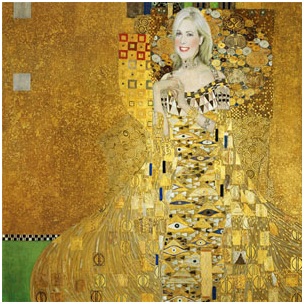
And what of Delacroix? Who would pass up the opportunity to repurpose "Liberty leading the People" as an expression of the passion she displays in leading the charge to discover the old, the new and yes, the hereto undiscovered territories of the mind and human creativity?
And this is not about singling Jennifer out as an exception here. There are literally thousands if not hundreds of thousands of professionals actively participating in the global movement to build a brand using social media today. The point being made here is, by wrapping Jennifer up in these old memories, we are merely offering an old way of seeing what the new way of seeing is all about.
It is merely the admission that we are struggling to comprehend what makes the new world so special. So we simply reference the past to make it easier for all to comprehend. We confuse pastiche for art. The meme with meaning. This however is not to say that the pastiche isn't without merit. One only has to recall Warhol to understand this. So let's try a simple trick. Let's invert the pastiche. Let's reimagine "Liberty leading the People" in the age of Twitter. If only to illustrate the old world reality of the virtual spectacle of the "real time" exchange of the spectacle.
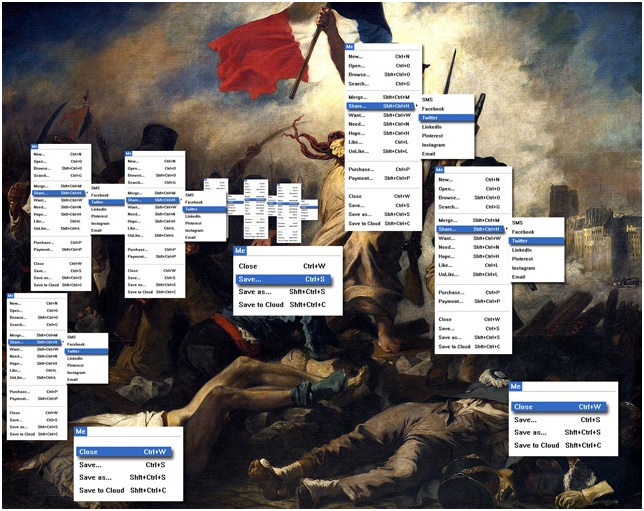
Here then is not so much Delacroix's "Liberty leading the People" as perhaps "Twitter bringing the people closer". The list as spectacle. Life on the menu. The key insight of course being the uniformity, rather than the diversity, of the post, post modern existence. Our real lives seemingly hidden behind the lists we make.
The key point I am trying to make here is simply this. The lists, the collections, we create online, be they on Twitter, Google, LinkedIn, Facebook are the post, post modern portrait. We are no longer a reflection of our image but our thoughts and actions.
In the age of the ubiquitous digital camera phone we live our lives, somewhat paradoxically, as a list.
Hold onto that thought.
Last year Marc Shillum's was at SXSW promoting the idea that branding is about creating patterns, not repeating messages. This year John Hegal was at SXSW promoting the idea of Forget Stories. Your Brand needs a Narrative.
Scratch the surface and you'll discover these are fragments of the same argument. Not so much the end of storytelling. More storytelling meets Metcalfe's Law. Less Storytelling 2.0 more Storytelling ^2.
Narratives as patterns, patterns as narratives.
But what if patterns don't matter? What if patterns are irrelevant? What if patterns are an illusion. Little more than ghost image reconstructed out of the big data by question seekers who's ideas are shaped by old media thinking?
Go back to the very beginning of this journey and you'll discover we spent some time examining what ailed the newspaper industry. Now one of the charts to emerge from that study was this one explaining that the real problem wasn't making money online, after all online advertising is the most expensive advertising channel ever invented, it was being sticky.
It was keeping the audience engaged.

Indeed one could simplify this study down to pages and lists.
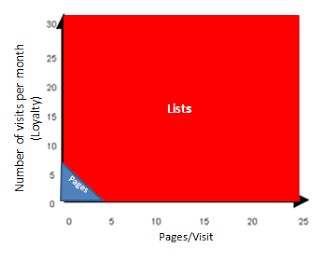
One look at the chart and it quickly becomes apparent that web pages aren't engaging enough to keep an audience. But list engines in all shapes and sizes apparently are.
We don't so much live life on the web but live life on the lists.
We spend most of our time attending to, creating and exploring lists. Be they lists of messages or lists of search results or lists of application data (e.g. Trading Systems).
Understand this and you will see why this next chart comes as no surprise.
I have created this next diagram simply to explain why patterns are (mostly) irrelevant.
Imagine the average web page. That is the big circle. The little dots in lower right hand side indicate the probability of you leaving that web page to visit another web page. Be it an ad or a hyperlink in embedded in the text.

As you can see the probability is low. So the next question is where do you go if you are not going to stay on that web page? The answer is back to the list you came from.
It all comes down to a question of bounce. We don't surf the web we simply bounce back and forth off our preferred list. Be it Google, Facebook or Twitter.
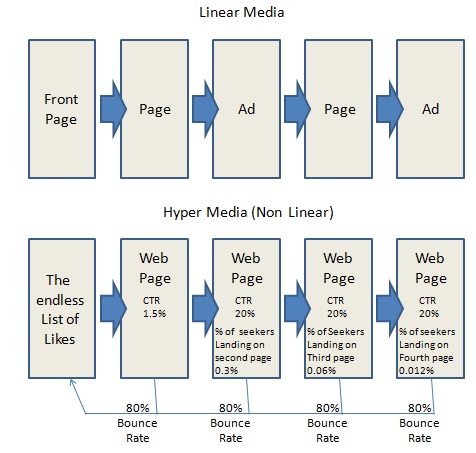
Either way the bulk of the activity is conducted on the list engine of your choice. Not the web.
Indeed if we mapped the probability of you leaving your list engine, landing on this page and then clicking on one of the hyperlinks embedded in the text it would look like this.
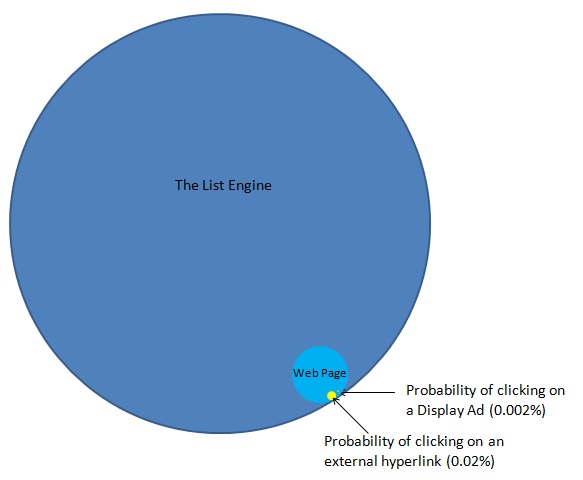
You see the problem is the Hyperlink, the very thing that glues the network together is fundamentally redundant. It only appears to have meaning when we aggregate all this lack of activity, pack it into a big box and begin to mine it for behaviours. And yes, there are any number of successful business models on the web based around this idea that the aggregation of clicks is valuable. But the reality is the real patterns of behaviour are not being revealed in the clicks but in what people are doing with their lists. The web of hyperlinks has been usurped by the list. The network has been usurped by the database.
Which brings us to a number of observations. Seemingly
• Lists are more important than patterns.
• Lists are more important than connections.
• Lists are more important than connecting the patterns (i.e. the Big Clickstream Data).
• (This implies) Lists are more important than narrative.
Hold onto that thought.
Now, if you are starting to think that, online at least, Brands don't so much need narratives but lists, and the art of creative advertising has moved on from storytelling to list making, you would be right. Because this is what a Brand called Jennifer Sertl has to teach us.
"You shall know me by my lists"
Old fashioned Radio, Magazines and TV are all about the manufacturing of celebrity - the close up, the look, the image, the Brand moment - this medium is all about the manufacturing of the list. The medium is the message and this medium is all about lists. The Branded list.
So the future of branding isn't so much an endless narrative but more just an endless list.
But that would be to miss the key point. The weakness in the model. Which is self evident in the diagrams. And that is the list is the objective. The list is the message. Not the brand. What you do on the list isn't so much a pointer to the brand (e.g. the Brand's web site) but back to the list. And this is why the only global Brands being built online today are list engines. Be it Google, Facebook or Twitter. The global brands to emerge from this medium are list engines. Places on the network where the spectacle of the exchange of spectacles takes place, preferably for all to see.
By frequenting the list you become part of the spectacle. Once you leave the list you leave the spectacle behind. That's why you are so eager to bounce back rather than continue on with your journey across the web. This is also why online advertising fails so dismally. It is an invitation to leave the spectacle. It's like saying to somebody at the bar, leave your drink behind, leave your friends behind and step outside. The response being at best the question Why? More often than not simply the turning of the head back towards the spectacle. The clear message being you are wasting your time and money because I have no intention of leaving where the action is. If you want to engage me get on the list. Become part of the action. Become part of the spectacle.
And here in lies the problem, or at least the challenge, for those who specialise in manufacturing the Branded moment. The branded list is awash with Branded moments, indeed, arguably awash with branded (sub)lists. The branded moment is little more than confetti thrown at the parade. The passing spectacle that is the endless list.
Find me, find you and let's exchange... on the list of our choosing, of our building, of our shared creation, of our shared meaning.
This veritable mandelbrot of patterns within patterns is in reality an endless fractal landscape of lists within lists within lists.
Hold onto that thought.
Of course there are a multitude of online Brands called Jennifer. Perhaps the most famous of all being that early pioneer of the dot com spectacular JenniCam.
JenniCAM and her fellow "performance artists" set the world's imagination alight when they turned their personal lives into a 24/7 reality TV show. In many ways a signal of things to come at the dawning age of social. Pioneers if you like. But somehow, almost 20 years on, it all seems a bit tame by comparison to today's free for all.
And it points to the question. What is more revealing? What is the greater spectacle? What is more titillating? The furnishings of the bedroom or the furnishings of the list?
Looking back over the decade since Jennicam went "offline" it would appear that the "Lifecasters" had more influence on the future of TV than the future of the web. As TV became more "real", the web became more social. But look again and you'll see just two sides of the same trend in media. The social narrative. The power of people to influence other people. The network narrative.
Today we live in a world awash, not so much with "Lifecasters", but with "Listcasters". The peoples of the list. Life explored, and at times expressed, if not lived, as a list.
And to waste time analysing the social value of these endless conversations between these ubiquitous lists of peoples that (mostly) never meet in real life would be to miss the point. To miss the opportunity to understand their aggregated value. You see these lists are best understood as threads. The web pages and videos shared, exotic fragments of cloth. The activity is one of life tapestry. The manufacturing of an *American* quilt.
A quilt that wraps each "Lifecaster" in a cloak of many colours.
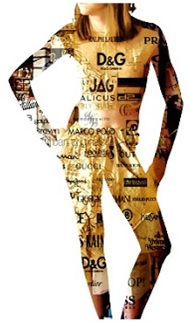
So where as the "Lifecasters" of the dot com era chose to expose themselves to the world, the "Listcasters" of the social media era choose to wrap themselves in tapestries of the world.
The list as a masquerade ball. What I have described before as the virtual pheromone economy.
But here in lies the rub as it were.
You see the "Lifecaster" exposed themselves to the world for all to see exactly who they were. Life stripped bare. Raw and unedited. They were to TV what punk was to music. Brutal, reactionary, edgy. A response to the excess of glam and disco.
On the other hand the "Listcasters" are the new glam revival. After all the movement was pioneered by Lady Gaga. The "Listcasters" are merely busying themselves in personal homage, following in her footsteps. They are, to put it succinctly, busy exposing to the world the person they dream to be. The person they want to be. The person the hope to become.
Understand this and you'll recognise the true value of the big data generated by the list engines - Be they Twitter, Facebook, Pinterest, Google or LinkedIn.
You see the "big data" of a "Lifecaster" is of little value to the marketeer. At best you would describe it as desperational data. However the "big data" generated by a "Listcaster" is pure gold. This is aspirational data. After all if the service is free, the product is you.
"Listcasters" believe themselves to be build a brand online. In reality they are generating an aspirational profile. "You shall know me by my lists". This is who I want to be. This is who I am becoming.... am I who you want me to be? Because if I am not, I can easily make another list. I can be any list you Like.
And yes hold on to that thought. Keep it front of mind. Keep it close to your heart.
At least until the next time you have the urge to Tweet.
Postscript
Jennifer Sertl asked yesterday on twitter "@excapite how could you know what a huge Blondie fan I am?".
Truth is I didn't. I just matched the cultural signals embedded in her portrait and matched it with a celebrity stereotype - Or what Gore Vidal would have described as mass media's archetypal character types. The 70's Blondie (Debbie Harry) of course following the lineage of Jean Harlow (30's), Rita Hayworth (40's), Marylyn Munroe (50's) and Bridget Bardot (60's) as the defining the "Blonde" of her generation.
All of which allows me to introduce an new idea.
A new social networking concept best understood as "mutually assumed deconstruction" or MAD for short.
And yes the idea has its roots in mid to late 20th century political thinking (i.e. MAD - mutually assured destruction). It also points to the idea that the function of *nice* - you'll notice I am now in the habit of substituting the word *nice* for *social* - media is to send out social signals that are deconstructed by others. Which in turn takes us back to the murmuration of starlings as a logical model for understanding the network effect, the rule of 7 influences as a result of the limitations of short term memory and of course the primacy of signals both within and outside of the network in shaping the movement the network - or what is better understood as the flock.
Jennifer uses a lot less words to put a far more positive spin on this idea. She simply calls it resonance. And yes there is much to learn here. Anyone who can compress these complex ideas into a single word either knows a lot about branding or is a natural.
But back to Blondie and the idea of "mutually assumed deconstruction". You see in this theatre of signalling across the social network brands, and by brands I mean celebrities, services and products, act as a kind of signalling short hand. They allow us to nanocast complex signals into public places in such a way that can be decoded by the flock simply because the answer to these complex signals have already been broadcast to the world via the mass media. Indeed this is the function advertising and media, to create the language of signalling that shapes the way we communicate with one another. Both verbally and none verbally.
Think of it as a pyramid of signals. At the top of the pyramid are the broadcast signals. The cultural norms if you like. Brands as aspirations. At the bottom of the pyramid is the network, the flock, each one of us unique in our curation of those branded aspirations, and of course our distortions and plays on those branded aspirations.
And here in lies the root of the problem I have with *nice* social media as a brand building channel.
In network theory we talk about the strength of weak ties. Strong ties bring us to rest. Weak ties take us to new places. Weak ties are what creates movement. The problem being of course this is network theory housed in a petri dish. Not only does it assume humans are like ants or bees. Swarm intelligence. When we are clearly more tribal. We hunt in Huxley's packs. It also fails to take into account that broadcast media like TV, Cinema, Magazines and Radio had already solved the network signalling problem.
Who cares if weak ties can move an individual actor across the network when you can inject a signal into the network that moves a generation to adopt a style, a persona? To immerse themselves in the activity of mutually assumed deconstruction based almost entirely on the cultural signals you have created?
In this context *nice* social media isn't an efficient model for modifying to generic codes of public signalling. It is the forum for amplifying the activity of mutually assumed deconstruction. Hence the logical counterpoint to this idea that "you will know me by my lists" is "I know you by deconstructing your lists" or more accurately by the patterns of insight revealed by aggregating and deconstructing your collective signals.
I construct for you to deconstruct. You construct for me to deconstruct. Resulting (hopefully) in Resonance.
And in the end this is what the noise is all about. Social signalling in the hope of finding resonance.
The point being of course is in a networked economy it is the branded experience created during the era of mass media that holds all this activity together today.
And that's why things will only start to get interesting when the cultural signalling provided by the mass media becomes just a memory. What happens to the network economy when the global cultural short hand fragments into 7 billion stories? What happens we are all living madly together under a thatched roof? What happens to the network narrative then? Resonance ^ Resonance?
I wonder...
Copyright 2013 Digital Partners Pty Limited. All Rights Reserved.